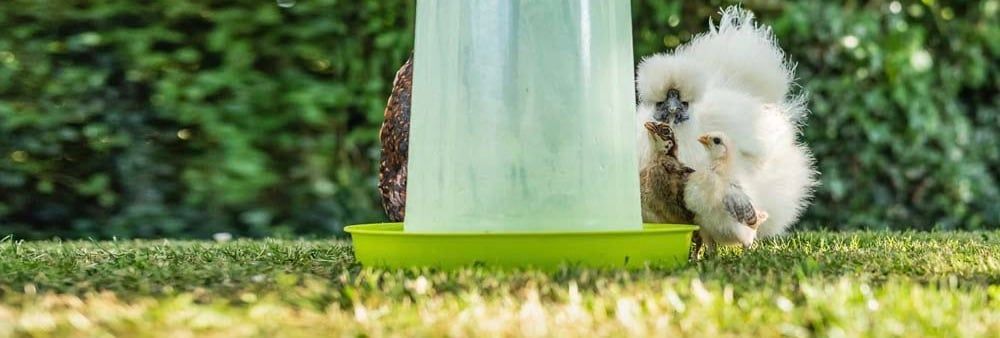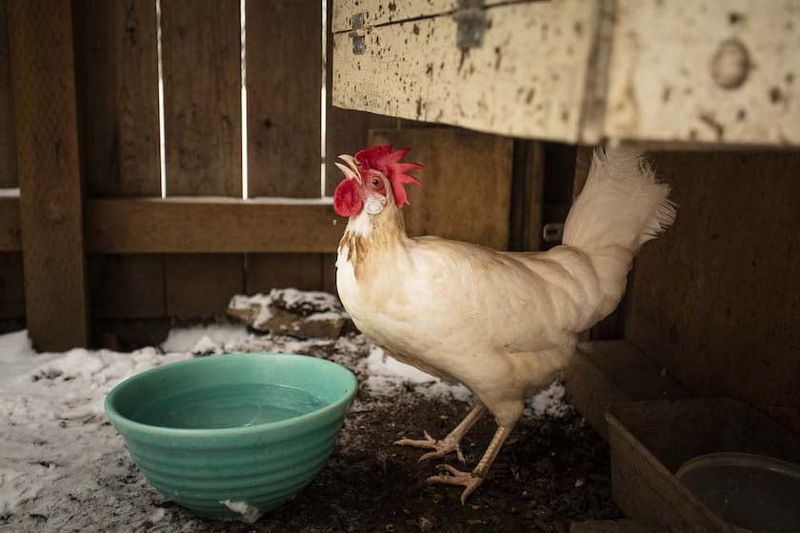Summer Water Myths and Misconceptions


Written by Dr. Bridget McCrea
June 10, 2023
This time of year, chicken-keepers look to new and different ways to care for their flocks, and changing to a different style of waterer often heads the list.
But when faced with an unending array of opinions from flock owners, it can be hard to make a choice about what will work best with your birds.
What follows should help you better choose as we delve into myths and misconceptions about how to provide water for your birds.
#1
The larger the waterer the better.
The size of the waterer you choose needs to be based on a few different factors. The first factor that you should consider is the number of chickens that you have in your flock. Your chickens should never run out of water on your watch.
You need to provide a source of water that is large enough for them to drink from all day, and all night if they should be inclined.
That may mean you are refilling a waterer daily. For some of you, this may seem an inconvenience, given your personal daily routine or work schedule.
Cleaning waterers daily is part of the routine and does not have to be a chore if you use the right tool for the job. Depending on the type of waterer you use, a simple toilet bowl brush is suitable for quick daily cleaning and rinsing prior to refill. However, keep in mind that weekly cleaning and disinfection is still part of the routine.
The waterer size should be large enough for you to get your hand into or be large enough for your cleaning brush to get into for scrubbing.
Open water systems are dirtier overall than closed water systems. If you want less work, then choose a closed system and your chickens will thank you.
You can also set up your waterers so that they are closed system that require less cleaning. A nipple drinker system is a perfect example of this. Some cleaning is required with closed water systems—but only once a month versus weekly with open water systems.
You are a part of this equation. A big waterer may be too heavy to lift. Given your personal physical limitations, you should consider the size of the waterer when full. Remember, a gallon weighs around 8 pounds. Do not invest in a waterer that hurts to carry when full. Or consider setting up your watering system so that it stays put and you fill it using a hose. Remember, we don’t stay young forever, but keeping chickens helps make us feel pretty lively!
#2
Plastic waterers are better than metal waterers.
Unless you are in a region that has cold weather, you really need not be too concerned with plastic versus metal waterers. The time that you really need to take this topic into concern is in winter. Plastic weakens and can crack if the waterer undergoes regular freeze and thaw cycles. The plastic waterer was not really meant to stand up to this kind of temperature fluctuation and it stresses the product. Metal waterers can handle the freeze and thaw cycles.
If you place your waterer on an electric warming device to prevent freezing, then you can potentially get a longer life out of your plastic waterer.

In addition, metal waterers can handle being dropped more readily than plastic which can crack. Alternately, metal waterers can be heavier which may be a drawback for you. Also, metal waterers do not do well if you add any acids to your water. I am specifically speaking about vinegar which is also called acetic acid. It can erode the metal. So, is one kind of waterer better than the other? It all depends on your situation and what you plan on doing with your particular flock.
#3
Nipple waterers seem to leak, so traditional waterers are a better choice.
Leaks happen with waterers, even with open water systems. You put a waterer down crooked or a crack develops that you did not see and then Yuck! You find yourself with a coop that needs mucking out. But the question is really about nipple drinkers and why they leak.
Well maintained nipple drinkers should not leak. If the seal goes bad, then they are easy and really affordable to replace. If you are lucky enough to live in a part of the country that has a lot of chicken farms, then your local farm supply store will probably have replacement O-rings or replacement nipples.
Pro tip: It is a good idea to order a few replacement nipples from any company that sends you a nipple drinker. Backups are always valuable to have and then you are not quite as put-out as if you had to run to the store (or internet) to get some more.
If you are using a bottom-style nipple drinker and you set your drinker down on the nipples, then they are really easy to break this way. I prefer the side nipples as this type of accident is less likely to happen. Nipple drinker systems can also leak if your hose pressure is too high—a pressure reducer on the hose may yield a better result. Of if you are using a gravity-fed nipple drinker from a 5 gallon or larger bucket, then you may need to fill your bucket to a lower level to reduce the pressure.
#4
Water cups are no better than traditional waterers because they still fill with debris and get algae build up.
This is true! Any open water system does gather debris and dust. Then you can get algae build-up. But the real question is…how did you let things get that built-up in the first place?
Daily water cleaning is still warranted in any open water system whether it is a cup under a nipple drinker or an open trough. In the old days, when trough systems kept water flowing through chicken sheds with a couple hundred hens, farmers would run a brush in the waterer twice a day to keep it clean. (They also had to prevent roosting on the troughs which is a whole other matter.)
Water cups, and their triggers, need daily cleaning with a scrub brush. This requires nothing fancy on the cleaning end as most people just use a plastic Brillo-type pad that molds to the shape of the cup for a quick scrub.
Algae builds up faster in waterers that are never cleaned. Also, this ties back into the statement earlier about fresh, clean water. If your water source contains a high level of algae or bacteria, then it may need treatment prior to giving it to your animals.
The plus of having water cups is that they can come in several different styles and be configured many different ways.
Some only fill if the chicken hits a trigger inside the cup. Unfortunately, they do not always completely empty themselves if the chicken does not drink all of the water. Some water cups are set up on a daily timer so that they flush themselves out and refill daily. This really works well for small groups of chickens and these cups only hold about a pint of water.
The fact that they flush themselves daily means that you need a place for the water to go when the waterer is flushed. (This might be a nice project for someone with an engineer’s mind.)
#5
The waterer should always be kept outside in the run, and never in the coop.
On the contrary, you can place your waterer wherever it makes the most sense for your situation. If it is too hot in the summer for a waterer to stay inside the coop, then move it out into the run. The overall goal is for the waterer to stay in a location that keeps it as cool and clean as possible without impeding the chicken’s access to the water.
One of the pluses of keeping the water in the coop is that wild animals and birds will be less likely to be drawn in by the water for a drink.

If you have a biosecure coop—and we all certainly hope that our biosecurity is up to snuff—then wild birds and rodents will not have access to your chicken’s water even if it is out in the run. By this, I am referring to a covered run that has wire small enough to exclude most mammals.
Bringing your water inside at night is also an option if you keep it out in the run during the day. However, your coop, in the hottest part of the summer, may be too warm for roosting at night. I may not be a bad idea to have a second or smaller water source indoors for the chickens to use when they enter the coop daily for egg laying.
During other times of the year, it may be too windy, dusty, or messy for the water source to be kept outside in the run.
No matter where you place your water source, you need to understand that if your waterer does not hang, then it is taking up square foot space in the coop or out in the run. Hanging water sources still allow the chickens to use more of the indoor or outdoor space by being able to walk under the waterer.
Tags:Plain Talk

Chicken Whisperer is part of the Catalyst Communications Network publication family.











